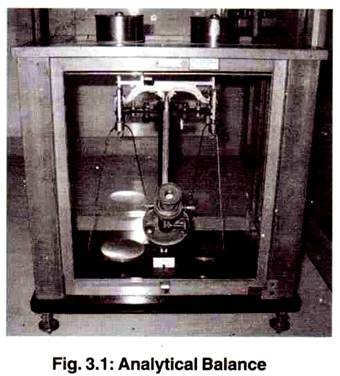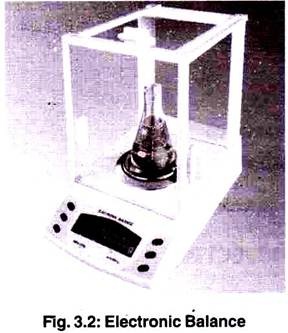The following points highlight the three main equipments that are used in hematology laboratory. The equipments are: 1. Equipment for Weighing 2. Centrifuge 3. Automatic Erythrocyte Sedimentation Rate.
1. Weighing Equipment:
Weighting equipments are essential in a medical laboratory. They are used to weigh substances for the preparation of reagents.
Types of Weighing Balances:
1. Analytical Balance:
Analytical balance is basically a two-pan balance. It has a simple operation by which a set of known weight is added in one pan while the other pan is balanced by the substance being weighed. This type of balance is fast fading out a modification of the balance.
Attached to one end of the balance is a beam with a weighing scale on it. Before weighing a substance, the scale is set to zero with the aid of a knob at the other end of the beam. A substance is weighed by moving the scale on the beam to achieve equilibrium. These balances take a maximum load of about 206gm with a sensitivity of 1mg.
2. Electronic Balance:
The advent of microprocessor in the field of electronics has brought about the introduction of extremely sensitive electronic balance. This type of balance correlates weight of a -substance with electromagnetic force. It is a mono-pan balance, supported by an electric coil which is suspended in an electromagnetic field.
Adding with to pan causes the coil to move. This movement changes the electric current within the electromagnetic field. This change is proportional to the weight of the substance, and is measured with an indicator system. The electronic balance, though expensive, offers accuracy, speed and ease of operation.
3. Direct Read-Out Top-Loading Balance:
There are two versions of this type of balance, electric or electronic. The electric one is less expensive and more robust. The two versions have the same advantages of being easy and quick to use because the weight of the substance is seen on the direct read-out scale, they also have a device which compensates for the weight of the weighing container.
Care of a Laboratory Balance:
Laboratory balances are delicate precision instruments which require careful handling and regular maintenance. The manufacturer’s instructions are to be followed as much as possible.
The simple rules for the care and maintenance of the balance are:
1. Position the balance on a vibration-free even surface, preferable in a draught-free area.
2. Level the balance with the help of a sprit level by adjusting the screws on the stand.
3. Zero the balance before weighing.
4. Always use forceps to add or remove weights when using a pan balance.
5. Never weigh any substance directly on the pan of a balance, use a weighing butter paper.
6. Keep the balance and the pans free of chemicals by brushing the pans off after use.
7. Always keep a desiccant inside the cabinet of analytical balance.
8. Check the accuracy of the balance regularly.
9. When not in use, protect the balance with a cover.
2. Centrifuge Equipment:
The centrifuge is used to rapidly sediment particles such as cells, which may be suspended in a fluid. The principle is that the centrifuge exerts a centrifugal force (CF), which is greater than that of gravity, and causes particles in a fluid to sediment.
The greater CF, the faster and more effective is the sedimentation. This centrifugal force which is the outward pull due to rotation is relative to the speed of centrifuging in revolutions per minute. The actual sedimentation achieved.
Type of Centrifuges:
i. Fixed Angle Rotor:
In the fixed angle rotor head centrifuge, the cups or tubes are held in a fixed angle. This position makes the process of centrifugation more rapid than the swing-out type. Also there is a less chance of sediment being disturbed when the centrifuge stops.
ii. Swing-Out Rotor:
In the swing-out rotor head, the cups or tubes occupy a vertical position when the centrifuge is moving, but swing-out and become horizontal. The particles are sediment at the bottom of the tube. In some models of centrifuge, interchangeable rotor heads are available.
Types of Models of Centrifuges:
1. Hand Centrifuge:
This is fixed to the bench and the handle is rotated manually. It gives low speeds only. It is now to be found in rural areas of the developing countries where electric power supply is erratic.
2. Battery Operated Bench Centrifuge:
This type of centrifuge is ideal for an area lacking regular electricity. It requires a lot of power so the battery will need regular charging and re-charging.
3. Electric Bench Centrifuge:
This is the most popular model used in the medical laboratory and they are available in different sizes and models with varying speed ranges.
4. Microhaematocrit Centrifuge:
This is used to spin capillary tubes which are used to find the volume of packed red blood cells or for concentration of some blood parasites. It can be either electric or battery-operated. The capillary tubes are filled with blood and are spun the centrifuge. The percentage of RBC filled column is read off using the haemtocrit reader. Usually, the spinning time is set for 3, 4, or 5 minutes at 10,000 to 15,000 rpm with the RCF or about 14,000g.
5. Ultracentrifuge:
This type of centrifuge permits refrigeration at higher speed while protecting the specimen from the heat that is generated by the rotors of the centrifuge. The essential temperature of this centrifuge varies from 15°C to 25°C during centrifugation.
6. Cytocentrifuge:
Cytocentrifuge or cytospin is a special centrifuge which is used for transferring cells in suspension to a circumscribed area on a glass slide. This instrument concentrates the cell suspension and minimizes cell damage.
Hematology Analyzers:
Hematology analyzers are used to run tests on blood samples. They are used in the medical field to do white blood cell counts, complete blood counts, reticulocyte analysis, and coagulation tests. There are hematology analyzers that are for human blood, which is useful for Clinical Lab., and research labs.
Features vary from one hematology analyzer to another, such as closed vial testing and open sampling testing. Certain hematology analyzers allow the user to choose the preferred testing type.
Other features to consider in a hematology analyzer are the sample size required, type and quantity of testing modes, speed in which the results are available, automatic flagging of results that are out of normal range, and the capacity of test results it can store.
3. Automatic Erythrocyte Sedimentation Rate (ESR) Equipment:
This equipment is acknowledged for their efficient and high performances.
Features:
i. Accurate
ii. Fast
iii. Convenient
iv. Practical
Description:
Erythrocyte Sedimentation Rate (ESR) is determines by measuring in millimeter per hour, the distance red cell have fallen after separating from plasma in a vertical: sed-rate pipette.
Esr-30 automatic esr dynamic analyzer introduces the photo-electricity technology. It will regularly scan and examine the positions of the red cells and the interface of the blood plasma, which is automatically controlled by the microcomputer. After processing by the microcomputer, the data will directly be displayed on the big lcd screen.
Hot Air Oven:
It is used mainly for dry sterilization for, drying glassware’s and some other metallic instruments.
Care & Maintenance:
1. Don’t forget to put off the main switch when the heating period is over.
2. Clean the hot air oven properly after use.
Incubators:
They are used for growing microorganisms on various culture media; it must be properly cleaned before and after uses.
Water Bath:
It is used to carry out various chemical reactions at specific temperature. Depending upon the requirement of an experiment.
Care and Maintenance:
1. The water bath should be sufficiently fitted with water before use.
2. Don’t forget to put off main switch after use.
3. Cover the water bath when not in use.
Microscope:
i. A Microscope is used to study proper and enlarged and well defined images of object, too small to be observed with naked eyes.
ii. Wipe the objectives by using a soft cloth by moving the cloth across.
Oil – Immersion Objective:
1. Remove the oil with an absorbent paper.
2. Moisten the cloth with xylene and wipe the lens carefully
Cleaning the Eyepiece:
1. Clean the upper surface of the eyepiece with a soft cloth.
2. Clean the lower surface of the eyepiece with cloth and paint brush.
Cleaning the Condenser:
1. The condenser is cleaned with a soft cloth, moistened with xylene.
Cleaning the Support & the Stage:
1. Clean with a soft piece of cloth with xylene.
The stage can be cleaned thoroughly well by using a petroleum jelly.








